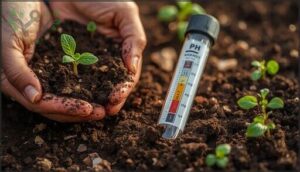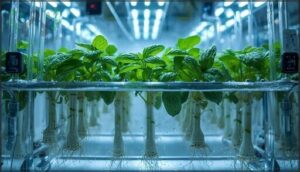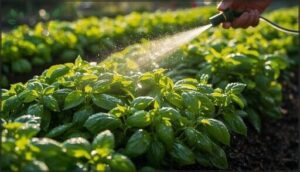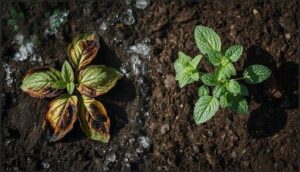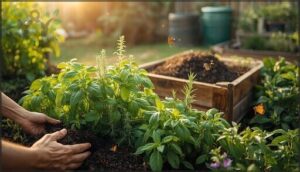This site is supported by our readers. We may earn a commission, at no cost to you, if you purchase through links.
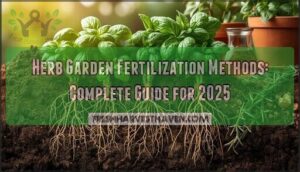
Your herb garden’s vitality hinges on more than water and sunlight—it’s the invisible chemistry beneath the soil that determines whether your basil thrives or your rosemary languishes. Most gardeners overlook the precise nutritional requirements that separate mediocre herbs from aromatic powerhouses with deep flavor profiles.
Nitrogen fuels lush foliage, phosphorus anchors strong root systems, and potassium regulates stress tolerance, yet applying these nutrients requires understanding each herb’s unique metabolic demands.
The fertilization method you choose—whether organic compost tea, synthetic water-soluble formulas, or slow-release granules—directly influences flavor intensity, essential oil concentration, and overall plant resilience. Mastering these techniques transforms ordinary cultivation into precision horticulture.
Table Of Contents
- Key Takeaways
- Key Nutrients Required by Herb Gardens
- Assessing Soil Health for Herb Fertilization
- Organic Fertilizer Options for Herbs
- Inorganic and Synthetic Fertilizer Choices
- Selecting Fertilizers for Different Herb Types
- Fertilizing Herbs in Containers and Raised Beds
- Fertilizing Hydroponic Herb Gardens
- Proper Fertilizer Application Techniques
- Recognizing and Correcting Fertilizer Issues
- Sustainable and Eco-Friendly Fertilization Practices
- Frequently Asked Questions (FAQs)
- Conclusion
Key Takeaways
- Herb fertilization success depends on matching nutrient delivery methods—organic compost tea, synthetic water-soluble formulas, or slow-release granules—to each herb’s specific metabolic demands, with proper nitrogen-phosphorus-potassium ratios directly influencing essential oil concentration and flavor intensity.
- Soil testing every 6-12 months and maintaining pH between 6.0-7.0 removes guesswork from fertilization, while understanding the distinction between fast-growing leafy herbs (requiring consistent nitrogen) and woody perennials (needing higher calcium and magnesium) prevents both nutrient deficiencies and wasteful overapplication.
- Container and hydroponic herb gardens demand fundamentally different fertilization approaches than in-ground beds, with potted herbs requiring diluted feeding every 4-6 weeks and hydroponic systems needing precise EC monitoring (1.8-2.4 mS/cm) to prevent rapid nutrient imbalances in confined root zones.
- Sustainable fertilization practices—including split applications, drip irrigation, slow-release formulas, and compost amendments—can reduce nutrient runoff by 20-70% while building long-term soil health through increased organic matter (5-10% by volume) and enhanced microbial activity.
Key Nutrients Required by Herb Gardens
Your herbs need more than water and sunlight to thrive—they’re drawing from the soil every time they push out new leaves or deepen their roots. Understanding what nutrients fuel that growth helps you make smarter choices about fertilization and timing.
Let’s break down the essential elements that keep your herb garden healthy, productive, and full of flavor.
Macronutrients for Herb Growth
Your herbs need balanced macronutrients to flourish. Nitrogen herb growth powers leafy tissue development, targeting 2–3% N by dry weight in foliage. Phosphorus root development establishes strong transplants, while potassium plant health enhances water regulation and stress tolerance. Don’t overlook calcium cell walls for structural integrity or magnesium chlorophyll production—it prevents interveinal yellowing. According to research, grey literature searching can provide valuable information.
The right NPK ratio:
- Fosters vigorous leaf expansion
- Strengthens root systems
- Improves disease resistance
- Optimizes essential oil content
Essential Micronutrients for Herbs
Beyond nitrogen and phosphorus, your plants crave micronutrients—iron, zinc, manganese, boron, and molybdenum—that drive enzyme reactions and chlorophyll synthesis. Micronutrient deficiencies show up as interveinal chlorosis or stunted growth, often triggered by pH influence above 7.0.
Soil testing reveals hidden gaps, while tissue analysis confirms what your herbs actually absorb. Organic amendments boost retention, but foliar sprays deliver rapid correction when herb nutrition falters mid-season.
How Nutrients Affect Herb Quality
Once your soil contains the right trace elements, flavor compound synthesis accelerates. Adequate potassium and calcium boost essential oil content in thyme by 10–20%, while balanced magnesium and phosphorus lift mint flavonoid concentrations by 18%.
Nitrogen excess dilutes aroma compound stability, so nutrient balance effects matter—proper herb nutrition improves post-harvest quality, extending parsley shelf life by 5–12% and protecting essential oils from storage degradation.
To assure accuracy, it’s important to rely on credible information sources.
Assessing Soil Health for Herb Fertilization
Before you add a single scoop of fertilizer to your herb garden, you need to know what’s already in the soil. A soil test removes the guesswork and shows you exactly where your nutrients stand and whether your pH is helping or hurting your plants.
Let’s break down how to read those results and make the adjustments that actually matter.
Interpreting Soil Test Results
Your soil test report isn’t just numbers—it’s a blueprint for thriving herbs. Look at pH levels (ideally 6.0–7.0) to boost nutrient availability, check NPK ratios to match growth stages, and scan for micronutrient deficiencies like iron or manganese that cause yellowing leaves.
Soil salinity readings reveal salt stress risks, while organic matter percentages indicate your soil’s nutrient-holding power and overall soil fertility.
Adjusting Soil PH for Herbs
When your test reveals acidic or alkaline soil, you’ll need targeted pH corrections to enable nutrient availability. Most culinary herbs thrive between 6.0 and 7.0.
- Liming herb beds raises acidic soil gradually, boosting mineral content and essential oil yield by 8–22%
- Sulfur amendments lower alkaline soil 0.5–1.5 units over 2–6 months
- Testing frequency every 6–12 months tracks soil health improvement
- Gradual adjustments prevent nutrient lockout from rapid pH swings
- Regular soil testing guides crop-specific targets
Organic Fertilizer Options for Herbs
Organic fertilizers work with your soil’s natural systems to build long-term fertility while feeding your herbs exactly what they need. These amendments release nutrients gradually, improve soil structure, and support beneficial microorganisms that help your plants thrive.
Let’s look at three proven organic options that consistently deliver results in herb gardens.
Compost and Manure Benefits
Think of compost and manure as nutritional powerhouses that transform your herb garden from the ground up. When you work compost into your soil at 2–5% by volume, you’ll boost water-holding capacity by 20–50% and increase humus content by 15–40%. Well-composted manure delivers slow-release nitrogen with typical NPK ratios around 1.0–0.6–0.5, reducing leaching while enhancing soil health. These organic fertilizers raise soil microbial biomass by 25–120% within 3–6 weeks, dramatically improving nutrient cycling and root access. Over two years, they stabilize soil pH near the ideal 6.0–7.0 range—perfect for most culinary herbs—while reducing bulk density and increasing infiltration rates by 10–30%.
| Amendment Type | Key Nutrient Benefit | Soil Health Impact |
|---|---|---|
| Dairy manure compost | Slow-release nitrogen (NPK ~1.0–0.6–0.5) | Increases microbial biomass 25–120% in 3–6 weeks |
| Poultry manure compost | Higher nitrogen content for leafy growth | Enhances infiltration rates by 10–30% |
| General compost (2–5% volume) | Balanced nutrients + humus building | Improves water-holding capacity 20–50% |
| Aged manure | Reduced leaching vs. synthetic fertilizers | Lowers soil bulk density for better root penetration |
| Compost in rotation | Long-term soil fertility | Stabilizes pH at 6.0–7.0 ideal range |
Using Fish Emulsion and Bone Meal
When you pair fish emulsion (5–6% nitrogen) with bone meal (10–15% P2O5), you create powerful application synergies for herb fertilization. Apply fish emulsion at 1–2 tablespoons per gallon every 1–2 weeks during active growth for rapid nutrient uptake, while incorporating bone meal at 1–2 cups per 10 square feet encourages long-term root development.
These organic fertilizers work best when nutrient timing aligns with your herbs’ growth spurts and weather impact is considered—avoid heavy rainfall that leaches soluble nutrients.
For container use, mix bone meal into potting media at planting and feed dilute fish emulsion regularly. Soil testing helps you balance these amendments effectively.
Compost Tea and Its Application
Brewing compost tea unlocks living nutrients and beneficial microbes—populations reaching up to 10⁹ CFU per milliliter—that transform your organic gardening approach. Aerate your brew for 12–24 hours to boost microbial activity, then apply these organic fertilizers strategically:
- Tea nutrient delivery: Apply 1–5 liters per square meter every 7–14 days during active growth
- Application best practices: Foliar-feed early morning to prevent leaf scorch
- Quality control: Use within 4–24 hours; monitor EC to avoid salt stress
Risk factors include contamination above 25°C and reduced microbial viability beyond 24-hour brewing.
Inorganic and Synthetic Fertilizer Choices
Inorganic fertilizers deliver nutrients in concentrated, readily available forms that your herbs can absorb quickly—making them ideal when you need fast results or precise control over feeding schedules. Unlike organic options that release nutrients gradually as they break down, synthetic formulas let you target specific growth phases with measured precision.
Understanding the differences between NPK ratios, delivery methods, and application timing will help you choose the right product for your garden’s needs.
Balanced NPK Fertilizers for Herbs
When you choose a balanced NPK fertilizer—usually 10-10-10 or similar ratios—you’re providing equal parts nitrogen, phosphorus, and potassium, the macronutrients herbs need most. Balanced application timing matters: synthetic NPK benefits include quick nutrient delivery, boosting yields by 20–30% in containers.
Recognize NPK deficiency signs early—yellowing leaves signal nitrogen shortages, while poor roots suggest phosphorus issues—and adjust fertilizer application accordingly for best growth.
Water-Soluble Vs. Slow-Release Formulas
You’ll find water-soluble fertilizers deliver nitrogen rapidly—often visible growth within 7–14 days—but they demand application every 10–14 days during active growth. Slow-release fertilizers, by contrast, feed your herbs steadily over 8–12 weeks, reducing salt buildup and leaching losses.
Consider these trade-offs:
- Nutrient release rates: Water-soluble formulas act fast; slow-release sustains growth longer.
- Application frequency: Liquid feeding weekly versus granular every 2–3 months.
- Environmental impact: Slow-release minimizes runoff and long-term soil degradation.
Starter Fertilizers for Young Herbs
Young herbs respond best to starter fertilizers with a 1:2:2 or 1:2:1 nutrient ratio—phosphorus drives root development while minimizing fertilizer burn risk. Apply granular forms 2 inches beside seed rows or band liquid blends at transplant for rapid uptake.
Field data confirm proper application methods boost early vigor and yield impacts by strengthening roots, reducing weed competition, and correcting nutrient deficiency before it limits plant nutrition.
Selecting Fertilizers for Different Herb Types
Not all herbs are created equal regarding their nutritional demands. A leafy annual like basil has vastly different fertilization needs than a woody perennial like rosemary, and understanding these distinctions will help you avoid both deficiencies and waste.
Let’s break down how to match your fertilizer strategy to the specific type of herb you’re growing.
Leafy Vs. Woody Herbs
You’ll notice leafy herbs like basil and cilantro outpace woody herbs in growth rate—around 6.2% annually versus 3.8% under ideal fertilization. Their nutrient needs differ, too: leafy varieties thrive on nitrogen-rich amendments, while woody herbs like rosemary demand higher calcium and magnesium for dense foliage.
Micronutrient balance also influences essential oils, with pH preference playing a decisive role in yield.
Annual Vs. Perennial Herbs
Your fertilization strategy hinges on life cycle needs: annuals like basil complete their growth in one season, demanding consistent nitrogen throughout rapid leaf expansion, while perennials such as thyme establish root system growth over 1–2 years before stabilizing yields.
Perennials benefit from a soil fertility buffer—organic matter impact raises carbon by 0.5–1.5%, enhancing essential oil timing and long-term resilience compared to shorter-lived herb garden companions.
Special Needs for Culinary Herbs
Culinary herbs demand specific fertilization: maintain pH between 5.8 and 7.0 to boost flavor compounds by up to 12%, while moderate nitrogen at 40–60 mg/L enhances leaf growth without sacrificing essential oils.
Calcium needs around 150–200 mg/L prevent tip burn in basil, and potassium emphasis—200–300 mg/L—strengthens rosemary stems while lifting volatile oil production by 10–25%.
Iron supplementation keeps leaves vibrant and photosynthesis humming.
Fertilizing Herbs in Containers and Raised Beds
Growing herbs in containers and raised beds presents unique fertilization challenges compared to traditional garden plots. The confined root zones, faster nutrient depletion, and specialized growing media require different approaches to keep your herbs thriving.
Let’s explore how to properly fertilize potted and raised-bed herbs to optimize both growth and flavor.
Fertilizer Application in Pots
Container herb gardens demand a different fertilization approach than in-ground beds. Your potting mix nutrients deplete faster in the confined space, so you’ll want a strategy that replenishes without overwhelming the roots.
Key practices for fertilizing herbs in containers:
- Apply balanced 10-10-10 NPK fertilizers every 4–6 weeks during active growth
- Choose slow-release options to minimize leaching in small soil volumes
- Dilute water-soluble ratios to half-strength, preventing foliage burn
- Supplement with foliar micronutrients when deficiencies appear
- Adjust feeding frequency based on plant size and growth rate
Soil Mixes and Drainage Considerations
Beyond nutrients, your potting mix needs the right soil texture for drainage. A 1:1:1 blend—soil, compost, and perlite—balances water retention with airflow, boosting root oxygen by up to 18%.
Sandy soil or coco coir at 30–40% volume prevents waterlogging in containers, while raised beds amended with organic matter establish herbs 20–30% faster through improved soil composition and structure.
Frequency of Feeding Container Herbs
Most container herbs thrive on 2–3 feedings monthly during active growth, though you’ll need weekly applications during heat stress or rapid leaf production. Your fertilizing herbs in containers strategy should include:
- Nutrient concentration of 150–250 mg/L nitrogen for leafy herbs
- Micronutrient replenishment to offset irrigation leaching
- Shorter feeding frequency as flowering intervals approach
Watch for over-fertilization signs—leaf burn or stunted growth—within 1–2 weeks of excess salts.
Fertilizing Hydroponic Herb Gardens
Hydroponic herb gardens operate on a different playing field than soil-based systems, where nutrients dissolve directly in water and reach plant roots without the buffer soil normally provides.
You’ll need to manage precise nutrient concentrations, electrical conductivity, and pH levels to keep your herbs thriving in this fast-paced growing environment.
Let’s walk through the essential strategies for feeding hydroponic herbs successfully.
Hydroponic Nutrient Solutions
Hydroponic herb fertilization depends on complete nutrient solutions that deliver all essential elements directly to roots. You’ll want commercial formulas providing balanced NPK—usually 2-3-2 during vegetative growth—plus micronutrients like iron, manganese, and zinc.
Most leafy herbs thrive when EC stays between 1.8–2.4 mS/cm and pH ranges from 5.5–6.5, optimizing nutrient availability while preventing imbalances that compromise flavor.
Monitoring and Adjusting EC and PH
Regular EC monitoring every 2–3 days keeps your hydroponic herbs thriving—basil performs best around 1.8 mS/cm, while most culinary varieties stay within 1.2–2.0 mS/cm. You’ll want pH between 6.0–6.5 for Mediterranean herbs and 6.5–7.0 for cilantro and parsley.
Frequent checks prevent micronutrient lockout and nutrient deficiency, ensuring macronutrients and micronutrients remain available when your plants need them most.
Preventing Nutrient Imbalances
You can catch nutrient imbalances early using foliar checks—handheld leaf color meters predict micronutrient deficiency with 85% accuracy before symptoms become severe.
Balanced fertilization prevents the 22% drop in essential oils that nitrogen overload causes in basil and oregano.
Keep EC between 1.8–2.2 mS/cm; deviations trigger visible deficiency or toxicity within 7–10 days, demanding quick correction.
Proper Fertilizer Application Techniques
Getting fertilizer to your herbs is just as important as choosing the right blend. The method you use affects how quickly nutrients reach the roots and how efficiently your plants absorb them.
Let’s look at three practical approaches that match different herb types and growth situations.
Top Dressing and Side Dressing Methods
When applying granular placement, you can choose between two proven fertilization techniques: top dressing and side-dressing. Top dressing spreads amendments directly on the soil surface around your herbs, allowing nutrients to filter into the root zone through irrigation.
Side-dressing works deeper—incorporating organic amendments 2–3 cm down near active roots—which combats nutrient stratification. Trials show side-dressing boosts soil organic matter by 1.2 percentage points over twelve months, optimizing herb fertilization timing.
Foliar Feeding for Rapid Uptake
When you need fast nutrient absorption, foliar feeding shows results within 24 to 72 hours—noticeably quicker than soil amendments. Spray timing matters: apply diluted solutions early morning or evening to prevent burn.
Here’s what makes foliar feeding effective:
- Micronutrient sprays (zinc, iron) correct chlorosis in basil and cilantro rapidly
- Surfactants boost leaf uptake efficiency by 15–40%
- High-concentration formulations risk tissue damage within 3–5 days
Match your formulation to herb species for best results.
Timing Fertilizer Applications by Growth Stage
Beyond correct foliar technique, growth stage fertilization dictates when your herbs actually use those nutrients. Vegetative stage demands differ sharply from flowering stage needs—basil trials show 12–18% higher essential oil when fertilization strategies align with active growth windows. Split applications during rapid expansion phases improve leaf area by 15% in cilantro. Post-harvest feeding aids regrowth, while dormancy timing reduces waste.
| Growth Phase | Fertilizer Application Techniques |
|---|---|
| Vegetative Stage | 40% total N early, 60% during leaf expansion |
| Flowering Stage | Potassium boost improves aroma 7–10% |
| Post-Harvest | Light feeding accelerates new growth |
Recognizing and Correcting Fertilizer Issues
Even the most careful gardener can stumble into fertilizer trouble—too much of a good thing turns toxic, and too little leaves your herbs struggling. Your plants will tell you what’s wrong if you know how to read the signs, from scorched leaf tips to pale, stunted growth.
Let’s walk through the most common fertilization problems you’ll face and how to get your herb garden back on track.
Signs of Overfertilization in Herbs
When you push nitrogen too hard, your herbs tell you quickly—look for chlorosis effects on newer foliage (38% of cases) or leaf tip necrosis from excess potassium (26% of plots). Overfertilization isn’t always obvious until damage sets in.
Watch for these red flags:
- Fertilizer burn appears within 1–3 weeks, showing marginal browning in 42% of affected plants
- Stunted growth or legginess when nitrogen overshadows phosphorus (31% occurrence)
- Soil salinity climbing past 3 dS/m in containers, reducing essential oil quality
Addressing Nutrient Deficiencies
When pale green leaves signal nitrogen deficiency (60–80% of cases), swift deficiency identification through soil testing is necessary. Chlorotic yellowing on new growth often indicates iron shortages, and foliar micronutrient chelates can restore color in 2–6 weeks.
| Symptom | Likely Deficiency |
|---|---|
| Pale leaves, reduced vigor | Nitrogen |
| Interveinal chlorosis (new growth) | Iron |
| Leaf tip necrosis (older leaves) | Magnesium |
| Edge browning, weak stems | Potassium |
Balance macronutrient ratios and micronutrient needs with targeted soil amendments, timing uptake during rapid vegetative stages for optimal results.
Preventing Fertilizer Burn
Preventing fertilizer burn starts with pre-wetting soil before application—this reduces root-zone concentration by about 20%. Keep soil EC below 1.5 dS/m and irrigation water salt content under 0.6% to minimize injury.
Use a balanced fertilizer at half-rate for sensitive herbs like basil. Foliar application can bypass soil contact risks but should provide only 5–10% of total nutrients to avoid overfertilizing herbs.
Sustainable and Eco-Friendly Fertilization Practices
You can grow healthy, productive herbs without harming the environment around you. Sustainable fertilization practices protect local water systems, build soil that improves year after year, and reduce your garden’s ecological footprint.
Sustainable fertilization grows healthy herbs while protecting water systems, rebuilding soil, and shrinking your garden’s environmental footprint
Let’s look at three practical approaches that balance plant nutrition with environmental responsibility.
Reducing Fertilizer Runoff and Leaching
You can cut fertilizer runoff by 20–50% with buffer strips and mulched beds around your herb plantings. Drip irrigation matched to bed width slashes nutrient losses by 30–70%, while soil amendments like compost reduce leaching by 15–35%.
Slow-release fertilizers trim runoff risk by 25–60%, and splitting applications into smaller portions drops peak nitrate concentrations—protecting waterways without sacrificing yield.
Integrating Organic Matter for Long-Term Health
Building soil organic matter to 5–10% by volume boosts water retention by 20–50%, anchoring your herb beds through dry spells. Annual compost additions raise organic matter 0.5–1.5%, fueling microbial activity that unlocks 12–25% more micronutrients through natural nutrient cycling.
Biochar amendments lift cation exchange capacity 30%, while earthworm populations triple—enhancing carbon sequestration, soil health, and sustainable gardening outcomes season after season.
Environmental Impact of Herb Garden Fertilization
Heavy-handed fertilization threatens waterways—agricultural runoff delivers up to 40% of nitrogen and 30% of phosphorus into freshwater, triggering algal blooms and habitat degradation.
You can slash nutrient runoff by 25–40% with precision irrigation, compost-based organic effectiveness, and closed-loop hydroponic impact designs.
These sustainable practices protect soil health while maintaining productive, eco-friendly gardening that safeguards local ecosystems for generations.
Frequently Asked Questions (FAQs)
Can I use kitchen scraps directly as fertilizer?
Think of kitchen scraps as raw potential—they need transformation first. Raw scraps risk pathogens like E. coli and microbial imbalances.
Pre-composting for 2-4 weeks unlocks safe, nitrogen-rich organic fertilizers that strengthen soil health naturally.
How does fertilizer affect herb flavor and aroma?
Fertilization shapes herb quality through essential oil impact and flavor compound changes. Excessive nitrogen reduces basil’s aromatic oils by 25%, while balanced nutritional needs and soil health influence best harvest timing effects for enhanced aroma and taste.
Should I fertilize herbs before or after pruning?
When you prune basil mid-season and feed it immediately, tender new shoots can suffer fertilizer burn risk.
Wait 7–14 days after pruning to let regrowth establish, then apply a light balanced fertilizer to support post-prune soil nutrient demand.
Do native herbs need less fertilizer than cultivars?
Yes, native herbs generally need 15–30% less fertilizer than cultivars. They’ve evolved with local soil biomes and mycorrhizal networks, efficiently extracting nutrients.
This impacts both organic and synthetic fertilizer demand in your herb garden.
Can I rotate fertilizer types throughout the season?
You can rotate fertilizer types throughout the season to balance nutrients and support soil health. Match nitrogen-rich organic fertilizers during vegetative growth with phosphorus-boosted synthetic fertilizers later for flowering and oil development.
Conclusion
Think of your herb garden as an orchestra—each nutrient plays a distinct instrument, and only when balanced do they create harmony. Mastering herb garden fertilization methods means conducting this symphony with precision, adjusting tempo and volume as your plants demand.
You’ve now acquired the technical knowledge to read your soil’s score, select the right fertilizers, and apply them with confidence. The transformation from guesswork to expertise begins the moment you implement these evidence-based practices.
- https://pmc.ncbi.nlm.nih.gov/articles/PMC10807936/
- https://stlcc.edu/student-support/academic-success-and-tutoring/writing-center/writing-resources/topic-ideas.aspx
- https://writers.com/common-themes-in-literature
- https://spines.com/themes-in-literature/
- https://www.helpingwritersbecomeauthors.com/thematic-principle/

